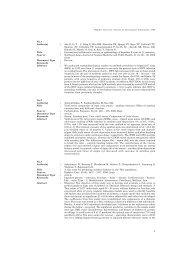Faculty of Science - Mahidol University
Faculty of Science - Mahidol University
Faculty of Science - Mahidol University
Create successful ePaper yourself
Turn your PDF publications into a flip-book with our unique Google optimized e-Paper software.
<strong>Mahidol</strong> <strong>University</strong> Annual Research Abstracts, Vol. 33 325<br />
INTERLEUKIN-5 REDUCES THE EXPRESSION<br />
OF UTEROGLOBIN-RELATED PROTEIN (UGRP)<br />
1 GENE IN ALLERGIC AIRWAY INFLAMMATION<br />
(NO. 858)<br />
Yoshihiko Chiba 1, 2 , Achara Srisodsai 1, 3 , Porntip Supavilai 3 and<br />
Shioko Kimura 1<br />
1 Laboratory <strong>of</strong> Metabolism, National Cancer Institute, National<br />
Institutes <strong>of</strong> Health, Bethesda, MD 20892, USA 2 Department <strong>of</strong><br />
Pharmacology, Hoshi <strong>University</strong>, Tokyo 142-8501, Japan<br />
3 Department <strong>of</strong> Pharmacology, <strong>Faculty</strong> <strong>of</strong> <strong>Science</strong>, <strong>Mahidol</strong><br />
<strong>University</strong>, Bangkok 10400, Thailand.<br />
Key words : Uteroglobin-related protein 1 (UGRP 1), Interleukin-<br />
5 (IL-5), Allergic asthma<br />
Airway inflammation is thought to play a major role in the<br />
pathogenesis <strong>of</strong> bronchial asthma. The precise role <strong>of</strong> individual<br />
inflammatory cells, mediator and asthma related genes in allergic<br />
lung diseases is not completely understood. The uteroglobin-related<br />
protein (UGRP) 1 was proposed to be an asthma candidate gene<br />
and play a role in regulating lung inflammation, however its precise<br />
function in the airways remains obscure. In this investigation, we<br />
used a mouse model <strong>of</strong> allergic airway inflammation to establish a<br />
relationship between UGRP 1 and IL-5 in airway inflammation.<br />
Ovalbumin (OVA) challenged mice demonstrate eosinophilia in<br />
airway tissues and high levels <strong>of</strong> IL-5 in bronchoalveolar lavage<br />
(BAL) fluid analogous to that found in bronchial asthma.<br />
Interestingly, these “OVA-challenged” mice show down-regulation<br />
<strong>of</strong> Ugrp1 expression as compared with the control group. Regression<br />
analysis further demonstrates a significant negative correlation<br />
between Ugrp1 mRNA expression in the lung and IL-5 levels in<br />
BAL fluid with r = 0.948 and P < 0.0001 when IL-5 levels were<br />
normalized by log transformation. Intranasal instillation <strong>of</strong> IL-5 to<br />
mice revealed an inhibitory effect <strong>of</strong> IL-5 on the expression <strong>of</strong> Ugrp1<br />
mRNA. Together, these results indicate an involvement <strong>of</strong> IL-5 in<br />
the down-regulation <strong>of</strong> Ugrp1 expression in airway inflammation<br />
such as allergic asthma disease.<br />
(Immunol Lett. 97(2005)123-129.)<br />
ANTIOXIDANT EFFECTS OF AQUEOUS EXTRACTS<br />
FROM DRIED CALYX OF HIBISCUS SABDARIFFA<br />
LINN. (ROSELLE) IN VITRO USING RAT LOW-<br />
DENSITY LIPOPROTEIN (LDL) (NO. 859)<br />
Vilasinee Hirunpanich 1 , Anocha Utaipat 1 , Noppawan Phumala<br />
Morales 2 , Nuntavan Bunyapraphatsara 3 , Hitoshi Sato 4 , Angkana<br />
Herunsalee 5 and Chuthamanee Suthisisang 1<br />
1 Department <strong>of</strong> Pharmacology, <strong>Faculty</strong> <strong>of</strong> Pharmacy, <strong>Mahidol</strong><br />
<strong>University</strong>; 2 Department <strong>of</strong> Pharmacology, <strong>Faculty</strong> <strong>of</strong> <strong>Science</strong>,<br />
<strong>Mahidol</strong> <strong>University</strong>; 3 Department <strong>of</strong> Pharmacognosy, <strong>Faculty</strong><br />
<strong>of</strong> Pharmacy, <strong>Mahidol</strong> <strong>University</strong>; 4 Department <strong>of</strong> Clinical and<br />
Molecular Pharmacokinetics/Pharmacodynamics, <strong>Faculty</strong> <strong>of</strong><br />
Pharmaceutical <strong>Science</strong>, Showa <strong>University</strong>; 5 Medicinal Plant<br />
Research Institute Department <strong>of</strong> Medical <strong>Science</strong>s, Ministry<br />
<strong>of</strong> Public Health, Thailand.<br />
Key words: Hibiscus sabdariffa; roselle; low-density lipoprotein<br />
(LDL) oxidation; antioxidant<br />
The present study quantitatively investigated the antioxidant<br />
effects <strong>of</strong> the aqueous extracts from dried calyx <strong>of</strong> Hibiscus sabdariffa<br />
LINN. (roselle) in vitro using rat low-density lipoprotein (LDL).<br />
Formations <strong>of</strong> the conjugated dienes and thiobarbituric acid reactive<br />
substances (TBARs) were monitored as markers <strong>of</strong> the early and<br />
later stages <strong>of</strong> the oxidation <strong>of</strong> LDL, respectively. Thus, we<br />
demonstrated that the dried calyx extracts <strong>of</strong> roselle exhibits strong<br />
antioxidant activity in Cu2+-mediated oxidation <strong>of</strong> LDL (p
















